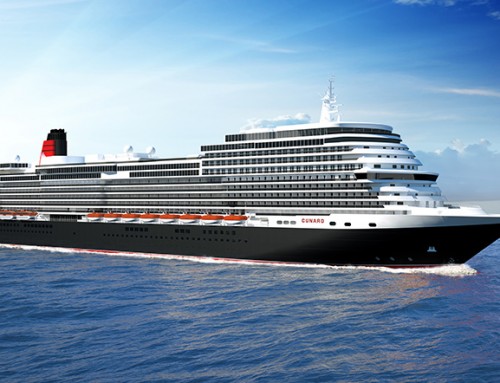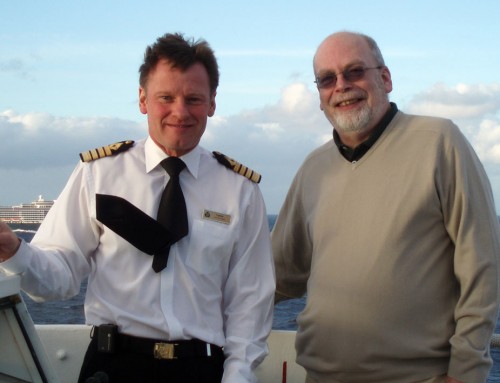 Don’t be surprised if relations between Norway’s Hurtigruten and our Royal Navy are a little frosty today. There’s a minor war of words taking place over claims that ice patrol ship HMS Protector had to rescue expedition ship Fram, carrying 202 passengers in Antarctic waters.
Don’t be surprised if relations between Norway’s Hurtigruten and our Royal Navy are a little frosty today. There’s a minor war of words taking place over claims that ice patrol ship HMS Protector had to rescue expedition ship Fram, carrying 202 passengers in Antarctic waters.
The story began when the Navy announced yesterday, under a headline proclaiming ICE PATROL SHIP FREES TRAPPED CRUISE LINER, that MS Fram had been surrounded by densely packed ice up to four metres thick. The story was quickly picked up by the BBC and several news outlets – including Captain Greybeard.
 Protector, described as the Royal Navy’s Swiss Army knife because she is “red, versatile, and always there when you need her,” took two hours to clear a path through the ice, according to the Navy statement.
Protector, described as the Royal Navy’s Swiss Army knife because she is “red, versatile, and always there when you need her,” took two hours to clear a path through the ice, according to the Navy statement.
Captain Peter Sparkes, born in Liverpool and now living near the ship’s home base in Portsmouth, said: “This is what we do … our ship’s company are highly trained and well equipped to deal with a spectrum of operations in Antarctica.”
Sub Lieutenant Rowland Stacey of the Royal Canadian Navy, currently on exchange with Royal Navy and serving with HMS Protector, added: “This was an extremely impressive feat – operations in ice can be very challenging, but HMS Protector made it look easy.”
Easier than you might think, according to Hurtigruten, who have operated the ice-strengthened Fram on two-month expeditions to Antarctica for the past five years.
An initial statement issued from their headquarters in Norway said: “On 13-14 January, Hurtigurten’s ship MS Fram had decided not to sail to one of its landing points of Brown Bluff in Antarctica as the ice conditions in the area that day were challenging.
“However, our reports state that HMS Protector was sailing in the area and they offered assistance to MS Fram so that the ship could sail to Brown Bluff. The ship was therefore escorted in and out of Brown Bluff by HMS Protector. This was a friendly gesture between two ships who are all part of the same ‘family’ when sailing in the remote areas of Antarctica.”
Later, possibly concerned about a potential safety backlash, Hurtigruten put out a further statement, disputing the Navy’s claims in stronger terms.
“Contrary to recent reports,” it said, “MS Fram was not involved in a rescue operation in Antarctica.”
It went on to quote Kim Crosbie, of the International Association of Antarctic Tour Operators, who happed to be on board HMS Protector when the incident took place.
Crosbie says: “MS Fram and HMS Protector were both at the north end of Antarctic Sound, it was a beautiful calm day with no wind. There was a significant amount of pack ice, enough to prevent MS Fram from getting into Esperanza and block potential access to Brown Bluff. The Captain of HMS Protector offered MS Fram the option to follow HMS Protector into Brown Bluff as it was heading that way for the site guideline’s review. MS Fram accepted. The joint landing at Brown Bluff went well, many Hurtigruten passengers came up to say thank you for getting them there, and for HMS Protector it was very helpful that Fram had put in temporary buoyage to mark the channel into the landing site.”
“On the way out of Brown Bluff the pack had congested and HMS Protector took the lead again, choosing the route and passage back northwards through Antarctic Sound. There was one section where the ice was particularly solid and MS Fram paused in a pool of open water while HMS Protector nosed her way through. Unfortunately the ice closed behind HMS Protector too quickly for MS Fram to follow and she was subsequently surrounded by dense pack. HMS Protector came back around and re-broke the channnel through. This was done with great panache, and quite quickly, enabling both ships to continue on through towards open water. Throughout, it was a beautiful still evening, extraordinary light and for all involved a good opportunity to exercise their capabilities in this unique environment.”
“This was not a rescue, but rather routine assistance. At no point was there risk to life or the environment. The whole day provided a very good opportunity for HMS Protector to prove her capabilities in these waters. However, perhaps most importantly of all this was a good example of the extraordinary cooperation and collaboration which takes place between those working in the international environment of Antarctica. Throughout the day, that both vessels worked so well together is testimony to the spirit of cooperation and collaboration that is prevalent amongst those ‘on the ground’ in Antarctica. ”
Rescue? Or routine assistance? Or could the incident possibly have been exaggerated in response to Argentina’s recently-renewed threats to the nearby Falkland Islands? After all, Captain Sparkes did add that his ship’s action was ” a clear demonstration of the Royal Navy’s global reach and operational preparedness.”
Take a look at the video of the operation at HMS Protector’s page on the Royal Navy’s website and judge for yourself.
►HMS Protector is actually a Norwegian ship, Built in 2001 as MC Polarbjørn (or Polar Bear), she was chartered by the Royal Navy in 2011 as a replacement for HMS Endurance, which had been severely damaged by flooding during routine maintenance.


PICTURES courtesy of the Royal Navy






Leave A Comment